Types of Urinals Guide
In the realm of restroom design and functionality, urinals play a pivotal role in providing efficient and hygienic solutions for different users.
From the conventional wall-mounted bowl, trough, and stall urinals to innovative waterless, sensor-activated, and portable designs, the world of urinals offers a plethora of options to suit various settings and user preferences.
Whether you’re a facility manager, architect, or simply curious about the fascinating world of restroom fixtures, this guide will take you on a journey through the diverse landscape of urinals, shedding light on their types, features, flush systems, suitability for different environments and factors to consider when choosing.
Wall-hung Bowl Urinals
These are the most common type of urinals and are typically bowls attached to a wall rather than the floor.
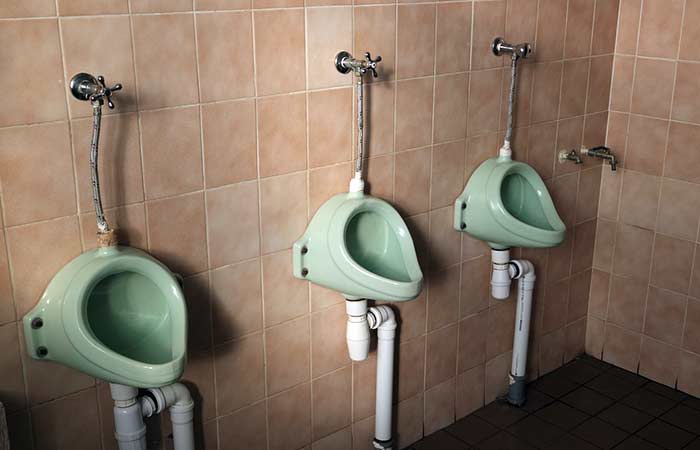
Their design allows for more efficient use of space, as the floor remains easy to clean. You can position them at various heights, making them more accessible for people of different heights and abilities. They are an ideal choice for public restrooms and other high-traffic areas.
A standard wall-hung urinal features a straightforward design with a porcelain or ceramic bowl mounted on the wall. It is available in various shapes and sizes, including elongated or round bowls.
Some designs of wall-hungs are waterless while others come with a flushometer or sensor system that automatically flushes the urinal after each use.
Others come with a flat back wall, or have a curved or sloping back wall.
There are also anti-vandal wall-hung urinals that are designed with durability and resistance to vandalism in mind.
High-efficiency wall-hung urinals, on the other hand, are specifically designed to minimize water usage while maintaining effective flushing.
Pros
- Space saving especially for small rooms
- Flexibility in installation- Can be installed at various heights
- Wall-hung urinals are easier to clean and maintain compared to floor-mounted urinals.
- Available in many styles and designs
Cons
- Installation requires wall reinforcement
- Can be more expensive than floor-mounted urinals
- Can be challenging to use especially for individuals with mobility issues
- Limited use in high-traffic areas.
Trough Urinal
These are elongated basins designed to accommodate multiple users simultaneously. They are often found in high-traffic areas, such as stadiums or concert venues.
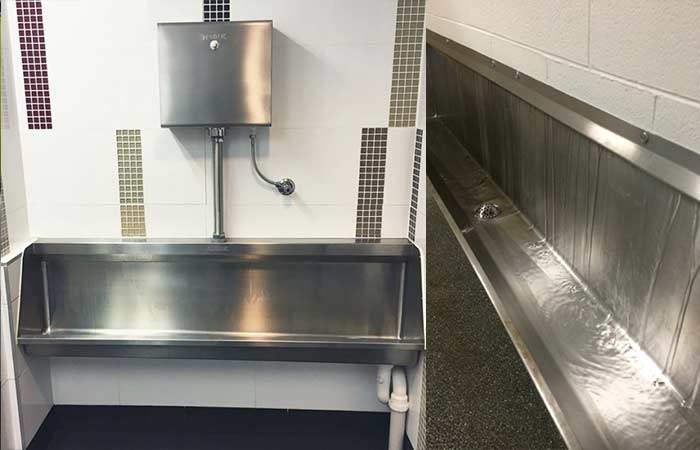
They are typically made from durable, corrosion-resistant materials such as stainless steel or porcelain.
Stainless steel is a popular choice for its durability and resistance to staining and corrosion, while porcelain is also a popular choice for its durability and ease of cleaning.
Their smooth surfaces and slight slopes allow for efficient drainage design and make cleaning and maintaining them easier.
Advantages
- It accommodates many users at once.
- The design of a trough-style urinal allows easy cleaning and maintenance
- It is water-efficient because it uses less than corner and flat-back types.
- Easy to use
Disadvantages
- Possible splashing can lead to the spread of germs and bacteria, which can cause illness.
- It can create an unpleasant environment for users because of its open design.
- It doesn’t provide privacy.
Portable Urinal
These are mobile and meant for temporary or outdoor use. They are commonly used in camping, outdoor events, or situations where restroom facilities may be limited.
Portable urinals come in various forms, including disposable bags, collapsible models, or portable restroom units.
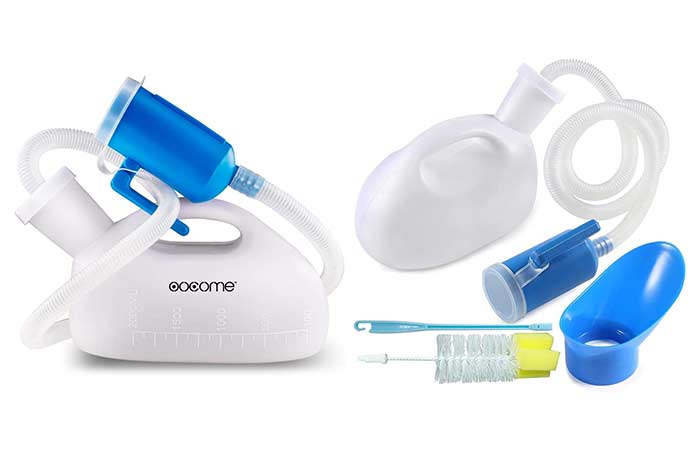
Advantages
- It is mobile; you can move it to a variety of locations.
- Compact and lightweight design
- Disposable bag types are affordable, lightweight and convenient
- Easy to clean
- It is delivered ready to use
Disadvantages of portable urinals
- You have to empty it frequently because it has a small storage unit.
- It can be a health hazard if you don’t maintain it well.
- Some units are costly
Stall Urinals
Also known as a partitioned urinal, these types of urinals are enclosed within a stall or partition for privacy. They are commonly found in upscale establishments or locations where privacy is a priority.
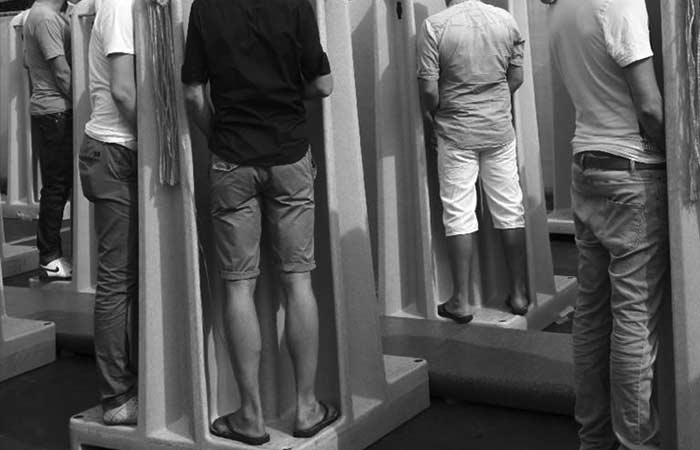
They are made from different materials such as porcelain, plastic, and stainless steel, which are durable and easy to clean.
They come in various sizes, styles, and designs to suit the needs of different buildings and facilities.
Advantages
- Provides privacy for the user.
- Help reduce the spread of germs and bacteria, as they are typically easier to clean and disinfect than urinals.
- It helps reduce the splashing that occurs when using an open urinal.
- Conserve water.
Disadvantages
- Lead to increased wait times for people who need to use the urinal because there is typically only one urinal per stall urinal.
- It can be less accessible than open urinals.
- Require more maintenance. The partitions, doors, and other features of the stalls can become dirty and need to be cleaned more frequently, which can be time-consuming and costly.
Squatting Floor-mounted Urinal
It is a unique type of urinal commonly found in Asia and other parts of the world.
The design of squatting urinals is simple and efficient. It consists of a ceramic or porcelain bowl set on the floor, with a small lip around the top to prevent splashing.
The bowl is usually wider at the bottom than the top, allowing for a comfortable squatting position.
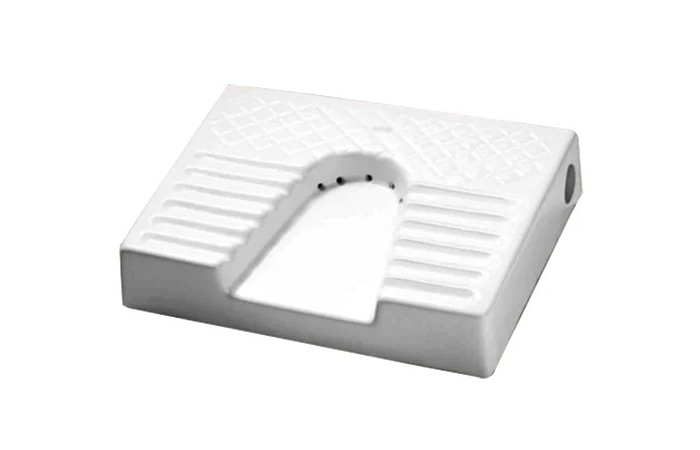
Advantages
- It is more hygienic because it allows for a better aim and less splashback. This means that there is less chance of spreading germs and bacteria.
- Compared to trough types, they offer privacy
Disadvantages
- It can be more challenging for some people, particularly those with mobility issues or specific physical disabilities. It also requires a different posture and muscle use than sitting in the toilets, which can be difficult for some people to adjust to.
- It is expensive
- It is not portable and cannot be accessed by people with disabilities.
Water-less Urinal
This is a type of wall-hung bowl urinal that does not use water to flush. It uses innovative technologies such as cartridge traps or disposable inserts to control odors and prevent splashing. These urinals are more environmentally friendly and help conserve water.
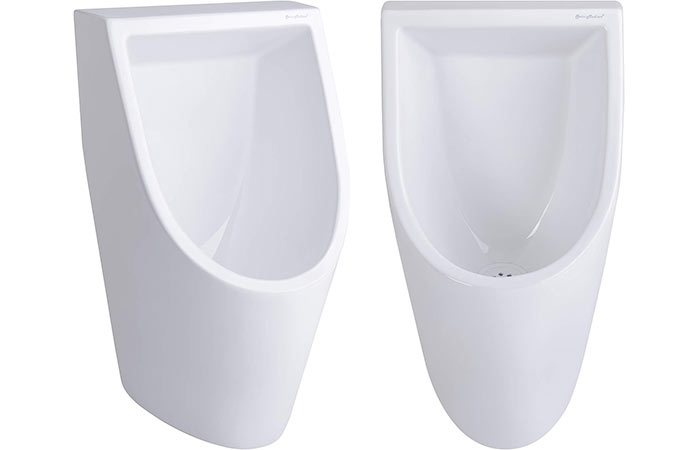
There are different water-less urinals including;
Liquid Sealant
This type uses liquid sealant cartridges to trap the urine and prevent odors from escaping. This not only saves water but also reduces maintenance costs and improves hygiene.
It is made from a combination of waxes and oils that form a barrier on the surface of the urinal bowl. This barrier traps the urine, preventing it from flowing into the drain. It holds the urine in a bowl until the janitorial staff removes it. The urine is held in the bowl until a janitorial staff empties it.
Integrated Traps
This also uses liquid sealant cartridges to trap the urine and prevent odors from escaping like the liquid sealant type.
Biological Block
A waterless urinal with a biological block contains a mixture of natural bacteria and enzymes. As urine flows into the urinal, it passes over the block, where the bacteria and enzymes begin to break down the urine.
The urine is then trapped in the drain and broken down. This process helps to keep the urinal clean and free of odors. The following are the pros and cons of waterless urinals.
Advantages
- Cost-effective and environmentally friendly solution for any commercial or public restroom
- It reduces maintenance costs since they don’t require constant replacement of flush valves.
- Hygienic
- Controlled odor
Disadvantages
- The initial cost of installation can be higher than traditional urinals.
- Are likely to clog
- The cost of maintenance and replacement of the sealant or cartridge can also be higher
- May not be compatible with all plumbing systems or building codes.
Handicap Urinal
It is a great invention that makes it much easier for those with disabilities to use the restroom. It is also called an accessible urinal. The manufacturers typically design them so a person can use them in a wheelchair or a walker, and you can adjust them to different heights to accommodate different needs.
This makes it much easier for those with disabilities to access the restroom, giving them more independence and convenience. Additionally, you can use the handicapped urinal to reduce water consumption.
With the help of a flushometer, you can flush the urinal with less water than traditional urinals, helping to reduce water waste. This means that not only does the handicapped urinal make it easier for those with disabilities to use the restroom, but it also helps reduce water consumption.
Advantages
- It is easier to clean than standard ones because it doesn’t have any fixtures like cover plates on it; you can wipe it down whenever you want
- Allows easy access to the urinal
- People with disabilities can use it.
- Provides a clean, sanitary environment
Disadvantages
- It is expensive.
- It has a different appeal than standard urinals, meaning it may need to match up better with other elements of your facility or your brand identity.
- It cannot accommodate many users at once
Pediatric Urinal
These are urinals specifically designed for kids. They are normally smaller in size and lower in height making them more comfortable and accessible for young users. They may also feature fun designs and characters to encourage children to use them.
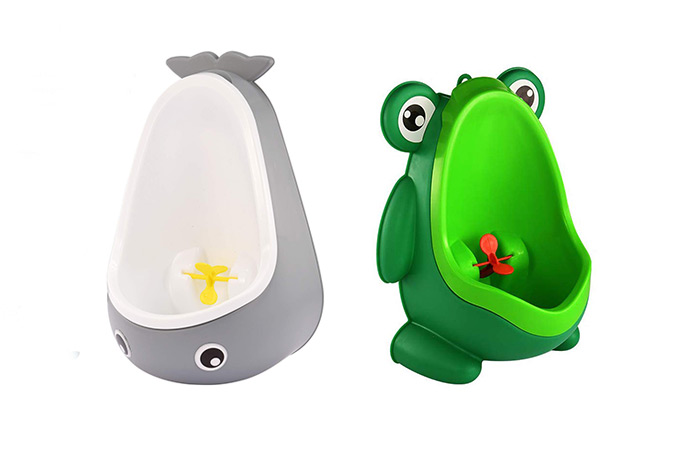
Pediatric urinals are often found in schools, daycare centers, or family-friendly establishments. This type of urinal serves as a training aid to facilitate a smoother and hassle-free transition from diapers to toilets for children and their parents.
Advantages
- Improves hygiene because it has smaller openings and higher splash guards to reduce the chances of urine splashing or missing the target.
- It can help to conserve water. Because it is smaller in size and uses less water than adult urinals
- It is easy to use
- Space-saving
Disadvantages
- Limited age range: It is not suitable for older children or adolescents.
- Children may have difficulty using a urinal properly, resulting in spills and splashes.
- It cannot accommodate many children at once.
Corner Urinal
It is a type of urinal that you install in the corner of the bathroom. It is available in different materials, such as porcelain, ceramic, and plastic. It is also available in various colors, including white, beige, and gray.
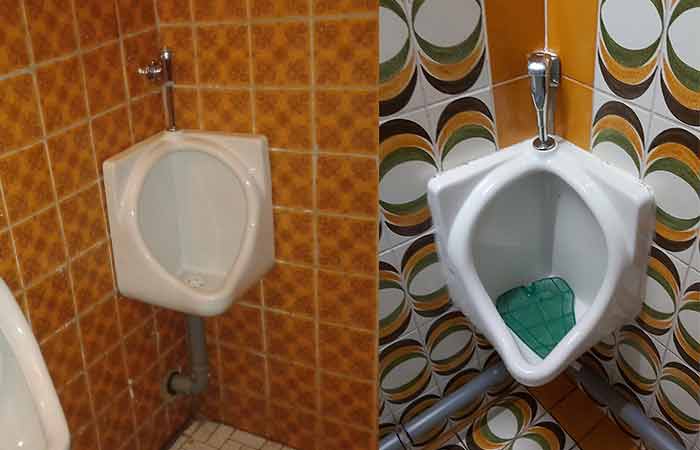
In terms of design, it comes in various styles and finishes to complement any bathroom decor. Some models feature sleek and modern designs, while others have a more traditional look. This gives you more options when selecting urinals for a particular space.
It is also popular in commercial and public restrooms. People prefer it because it is efficient in space utilization and its easy-to-clean design.
Advantages
- It conserves water. Many models use less water than traditional urinals, which can help to reduce the overall water usage in a building.
- It is durable because it contains high-quality materials resistant to damage and wear.
- It saves space
- Easy to clean
- It is private
Disadvantages
- It can be more challenging to install because of the angled shape and the need to fit into a corner, and it may require more complex plumbing and installation work.
- It is not portable and cannot be accessed easily by people with disabilities.
- It is expensive
- It is more prone to leakage because of the other joints and connections required.
- It cannot accommodate many users at once.
Makeshift Urinals
A makeshift urinal refers to an improvised or temporary solution for urination when restroom facilities are not readily available or accessible.
It is typically created using materials or objects that are repurposed to serve as a urinal-like structure.
While makeshift urinals are not as sanitary or convenient as purpose-built urinals, they can be useful in certain situations. Here are a few examples of makeshift urinals:
- Bottle or Container
- Natural surroundings like bushes
Customized Urinals
Some individuals or organizations opt to install customized urinals to reflect their brand or create unique restroom experiences.
These types of urinals usually feature personalized designs, colors, or logos to enhance aesthetics and make a statement.
Flush Urinal System+ Types
There are several different flush systems used in urinals, each with its own mechanism and water usage.
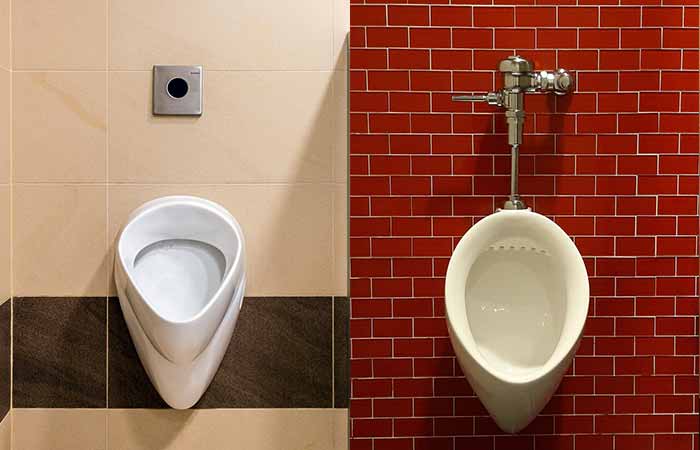
Manual Flush
This is the most basic and common type of flush system in urinals. It requires the user to manually activate the flush by pulling a handle or pushing a button. Manual flush systems are straightforward, reliable, and often found in older restroom installations.
Automatic Sensor Flush
It is a type of urinal that uses a sensor to automatically activate the flush mechanism, eliminating the need for a manual flush handle. This type of urinal is becoming increasingly popular in public restrooms, as they help prevent the spread of germs.
This urinal flush system use motion sensors or infrared technology, which are located near the top of the urinal, to detect when someone is using the urinal. When a person stands in front of the urinal, the sensor sends a signal to the valve to open and release water into the bowl.
After a set amount of time, typically around 15 seconds, the sensor sends another signal to the valve to close and stop the water flow. Once the person has finished using the urinal and walks away, the sensor detects that the person is no longer there and sends a signal to flush the urinal.
Timed Flush
Timed flush systems operate on a pre-set schedule, flushing the urinal automatically after a certain period. This type of system is commonly used in commercial settings to ensure regular flushing and maintain hygiene standards. However, timed flush systems may lead to water wastage if the schedule is not optimized.
Factors to Consider when Choosing a Urinal
When choosing a urinal, it is crucial to consider several factors to ensure you select the most suitable option for your specific needs. Here are some key factors to consider:
Bathroom space
Assess the available space in your restroom to determine the size and configuration of the urinal. Urinals come in various sizes and shapes, including wall-mounted and floor-mounted options. Wall-mounted urinals are space-efficient, while trough urinals are suitable for high-traffic areas with larger restroom layouts. Choose a urinal that will fit comfortably without taking up too much room.
Water Efficiency
Water conservation is crucial, especially in areas with limited water resources or a focus on sustainability. Look for waterless urinals or low-flow models that reduce water consumption without compromising performance.
Durability and Quality
Invest in a urinal made of high-quality materials that are durable and built to last. Urinals are made of materials such as porcelain, stainless steel, or plastic. Porcelain is the most traditional and durable option, but it can be heavy and difficult to install.
Stainless steel is lightweight and easy to clean but can be more expensive. Plastic urinals are less durable than porcelain or stainless steel but are also less costly.
Remember to check customer reviews and ratings to gauge the reliability and longevity of different toilet models.
User Demographics
Consider the demographics of the users who will be utilizing the urinals. For example, if the urinal will primarily serve children, pediatric urinals may be more appropriate.
Similarly, if the facility caters to individuals with disabilities, ensure the urinal meets accessibility requirements.
Privacy and Comfort
Determine the level of privacy required in the restroom by your users. Stall urinals or urinal dividers can provide enhanced privacy, especially in upscale establishments or locations where user comfort is a priority.
Maintenance and Cleaning
Consider the ease of maintenance and cleaning for the urinal. Some urinals feature anti-microbial surfaces or self-cleaning mechanisms, which can simplify upkeep and ensure a hygienic environment. Additionally, assess the availability and cost of replacement parts or cartridges for waterless urinals.
Cost
Determine how much is available for initial purchase, installation and ongoing maintenance. Different urinals vary in cost, and additional features such as sensor activation or customized designs may incur extra expenses.
Regulations and Building Codes
Find out information about local regulations and building codes that dictate the requirements for urinals in your area.
These regulations may cover aspects such as installation height, accessibility compliance, or fixture-to-user ratios.
Aesthetics and Branding
Consider the overall restroom design and branding of your establishment.
For your home, choose a urinal that complements your bathroom decor. Look for a color, shape, and finish that matches your bathroom’s style and personal preferences
For your business, go for manufacturers who offer customization options, to allow you to incorporate your logo, colors, or any other unique designs that match your theme.
References
- https://www.waterless.com/how-do-waterless-urinals-work
- https://www.tap-sensor.com/blog/what-is-automatic-urinal-flush-and-how-does-it-work.html
- https://www.buildings.com/ada-compliance/article/10191973/the-ada-compliant-restroom
- https://www.rethinkaccess.com/articles/accessible-urinals
- https://sswm.info/humanitarian-crises/camps/sanitation/user-interface/waterless-urinals-and-flush-urinals